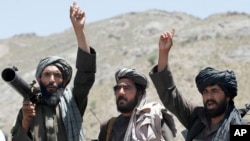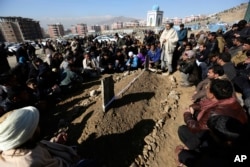The Afghan Government on Thursday pushed back against a U.S. Inspector General’s report that said Afghan forces are losing significant territory to Taliban insurgents and are not capable of keeping the nation secure.
“These calculations are not constant,” Mohammad Radmanesh, a spokesperson for the Afghan defense ministry, told VOA’s Afghan service. “Now we have recaptured many areas from the enemy.”
On Wednesday, the U.S. Special Inspector General for the Reconstruction of Afghanistan (SIGAR) reported that territory under the Afghan government diminished significantly in 2016 and that the Taliban made large gains.
“The Afghan national defense and security force has not yet been capable of securing all of Afghanistan and has lost territory to the insurgency," SIGAR reported.
"Last August, the U.S. military mission in Afghanistan … said only 63.4 percent of the country's territory was under government control -- compared to the 72 percent that the military said was controlled by Kabul in November 2015,” SIGAR noted.
But the Afghan government said the report does not take into account gains made by Afghan troops in retaking areas after Taliban assaults.
The government said it controls nearly two-thirds of the country's 407 districts. Afghan officials said the Taliban controls 33 districts, less than 10 percent of the national total, and a recent U.S. military assessment lists 116 districts -- more than one-quarter of the country -- as "contested" areas.
Overall, defense and interior ministry officials in Kabul said counterinsurgency operations during 2016 by Afghan police and military forces throughout the country killed more than 18,500 enemy fighters and wounded another 12,000.
Operation Shafaq
The Afghan national army last month announced the second phase of a campaign called Operation Shafaq, which began as a summer offensive. Afghan forces are concentrating on 13 of the country's 34 provinces, where Taliban fighters and the so-called Khorasan branch of the Islamic State group are stronger.
Afghan provincial authorities insist the focused effort by the national army has begun to pay off.
They cited their recent experience in a remote eastern district of the country where hundreds of men signed up to join a government-sponsored militia after the Islamic State fighters occupying their villages were driven off.
But the U.S. SIGAR, created to provide oversight of U.S. reconstruction funds for Afghanistan, said Taliban gains have come despite more the half of the U.S. current aid budget going to help improve Afghan forces.
"To combat the Taliban and other threats, the United States has provided more than $64 billion since 2002, including $3.45 billion in fiscal year 2016 alone, to support the Afghan National Army, the Afghan National Police, and the Afghan Air Force," Inspector General John Sopko said in the report.
Fighting upsurge
Fighting between Taliban and government forces increased during December in southwestern Helmand province, where insurgents are active in two key districts.
U.S. Defense Secretary Ashton Carter in December praised the "growing capabilities and resilience" that Afghan security forces have demonstrated in battling Taliban insurgency and conducting joint operations with American partners against IS.
Afghan forces are "generally capable and effective at protecting major population centers, preventing the Taliban from maintaining prolonged control of specific areas, and at responding to Taliban attacks," the SIGAR report said.










